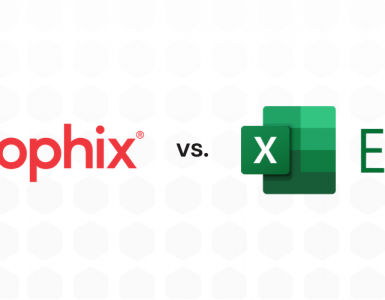FP&A is becoming increasingly strategic, but for many companies planning is time-consuming, and month- and year-end close processes are tedious.
These challenges hamper finance’s ability to respond to market changes, putting your business at a disadvantage.
If you want to improve your organizational agility, you’ll want to hear Alok Ajmera, CEO of Prophix, discuss how CPM software can support strategic, operational, and financial planning, forecasting, and a wide range of analytics for small-medium businesses (SMB).
We included a portion of Alok’s advice, which he shared on the WBSRocks podcast, hosted by Sam Gupta, below.
You can listen to the full episode on the WBSRocks podcast on Google podcasts or on their website.

Sam: Hey, everyone. Welcome back to another episode of the WBS Podcast. I am Sam Gupta, your host and principal consultant at the digital transformation consulting firm, ElevatIQ.
In today’s episode, we have a guest, Alok Ajmera, who discusses Corporate Performance Management software, also known as CPM, and breaks down its processes into tactical cost-saving and strategic components. He also explains the role and interactions of CPM and enterprise resource planning (ERP) software and what value these tools add to a small-medium business (SMB). Alok’s mission is to ensure that every customer, prospective client, partner, and employee around the world has a memorable and positive experience with Prophix.
So Alok, you are obviously passionate about planning. My first question is, how much planning is absolutely essential? Let’s say for SMB manufacturers, distributors, and retailers. How would you approach the planning for these organizations?
Alok: Yeah. Great question. Honestly, in my perspective, there’s no limit to how much planning you can do for an organization. And I’ll qualify that in a bit. But before I get there, let me take a step back. You mentioned cost-savings as one very important part of good financial management. But there’s another side that is often overlooked, which is well-structured, detailed planning is a strategic driver that can add substantial value to the organization. And it’s not just in cost-savings. So, let’s talk about both of those things.
There are the tactical components, which are more related to the cost-savings efficiencies. And then, there are strategic benefits, which have more to do with smarter decision-making and a much more forward-looking view of the organization. So, if I think about the tactical side, your statement is hundred percent correct. If you’re viewing performance management purely from the tactical side, it’s really based on cost savings.
If you think about an SMB manufacturer, retailer, or distributor, oftentimes they’re still running a lot of financial processes in a very non-digital way. That’s not to say they’re using pen and paper for financial processes. Although, surprisingly, we’ve come across organizations that still rely heavily on paper. But often, their financial processes rely heavily on Excel. And Excel is just a step above pen and paper in my mind. Although, I don’t want to worry the finance and accounting people out there. I’m not suggesting that there’s no place for spreadsheets. There’s absolutely a place for spreadsheets. However, there are steps you can take to help you streamline your processes.
Often, we find customers who are not doing consistent or continuous planning because it takes too much time and energy. So, they do one big budget at the beginning of the year and it takes two, three, four months to run that process. And when they finish, they put it down, exhausted, and then they move on and forget about it because of how quickly things change in our world today. And so, oftentimes, when they finish the first quarter, they abandon the plan because it’s too much effort to change it.
And so, one tactical benefit, if you think about it from a cost-saving perspective, is investing in capabilities, technologies, and process improvements so that you can streamline these efforts. At the end of the month, if you’re closing your books, it can take a day or two to get good, solid financials out quickly.
That’s the tactical aspect. If you have strong Corporate Performance Management practices within the business, you can reduce costs in terms of headcount spend, if you so choose. If something is taking you two weeks out of every month, and you can streamline that to a couple of days, then you can reinvest that saved time to do more meaningful things. You can understand the metrics you have and provide insight and guidance to the operating teams so smarter decisions can be made. Sam, I’ll pause there. Does that make sense on the tactical side of performance management?
Sam: It does. So, let’s talk about some of the features of CPM software. I have worked with large enterprise companies and, honestly speaking, I don’t even know if they were doing CPM practices right or not. Probably they were over-engineering, OK? So, in their case, they had very large development teams because they could not find off-the-shelf CPM software. So, I’m talking about the logistics of the CPM industry. In their case, the way they recognize revenue is completely different and they must find ways of optimizing it. I have seen this in a lot of different industries, such as the airline industry. So, I’ve mostly seen very bloated processes from a CPM perspective.
So, in your experience, how do processes and features vary across organizations, and what is optimal for most organizations?
Alok: Yeah look, you bring up a good point. Many enterprise organizations have very big finance and IT organizations. And so, although they have technologies and tools in place, they’re incredibly inefficient and so they don’t necessarily benefit from the agility that a good CPM solution would provide. What’s interesting is over the last decade, as the cloud has become more prevalent, is that a lot of capabilities that were once only available to enterprise organizations are becoming more available to SMB organizations in a much more easy-to-use, intuitive, and fluid manner.
So, you don’t need to acquire technology and have a giant IT organization to support you. And you don’t have to have over-engineered practices. They can be substantially more nimble and more agile, which is much more conducive for SMB organizations. In fact, SMB organizations, just by the nature of their size and alignment within the company benefit from CPM practices and solutions more than their enterprise peers.
Sam, let me give you a quick example. In the last twelve months, we’ve had this massively disruptive event with the pandemic. I remember in the Spring of last year thinking, “OK, what’s going to happen?” The wheels felt like they were starting to fall off and we were going into this incredibly uncertain time, without a good understanding of when would we come out of it. And so, what we ended up doing and what a lot of our customers did is incredibly detailed and very frequent scenario analysis.
So, if you’re an aerospace manufacturer, think about what you were feeling on March 31st, 2020. What’s going to happen to your demand forecast? What’s going to happen to the industry at large? And so, a lot of organizations were starting to do monthly and then weekly multi-area forecasts. Suddenly, we had our agile customers shifting gears and saying, you know what? It’s not enough to do a quarterly forecast to see how we’re trending through the end of the year. What we really need to start doing is close the books and then do a rolling thirty-six or forty-eight-month plan every month.
So, what does the world look like for the next three years? What are various scenarios if we have a recovery that’s sooner? Or what if the pandemic is prolonged? What happens if we have a supply chain issue? Rolling forecasts allow you to push these scenarios across multiple years, and then, most importantly, translate it across all your financial statements. Oftentimes, we get so consumed with looking at our P&L that we forget about the balance sheet, which at the end of the day is exceptionally important.
And I know CFOs understand what I’m saying. It’s what decisions are we making over the next couple of years in a very uncertain time? And how are we analyzing that? And how are we understanding how it flows down into the balance sheet and off, ultimately, into cash flow. And then doing that in an almost real-time manner with new data, new insights, and new objectives.
Sam: OK, amazing. So yeah, I definitely agree. In fact, I’m going to tell you a little bit of a story from a recent episode. We had one CFO on the show who was working with a manufacturer doing planning every month. And one day, they find out that they only had cash left for four months. Can you believe that?
This reminds me of another story about my accountant. When I work with my accountant, he really hates me. And the reason for that is because I want to save time, right? So, if I’m doing the financial statement, whether I capture the insurance amount in month one or month two, I don’t really care. As long as that is a part of the same P&L because we are not really closing the books –
Alok: Oh my god, Sam. All your CFO audience members are shuddering. They’re covering their ears right now [Laughs].
Sam: I know, right? My CFO also hates me because data quality is extremely critical for cash planning and forecasting. And that’s the reason why they are super particular about capturing expenses and revenue in the right months. So, my question to you is, are you seeing any capabilities in your space where you might be able to detect anomalies, such as with artificial intelligence? I don’t know what kind of advances have been made in terms of technology. So, they can really flag people like me, and my accountant doesn’t have to yell at me [Laughs].
Alok: Yeah Sam, you bring up a good point. There are absolutely technologies emerging that have very powerful use cases that can help streamline, in your example, anomaly detection. I’ll get into that in one moment. But let me dig into the data quality conversation.
There’s an adage that says, “garbage in, garbage out.” If you have a poor data structure, it’s hard to build on that to produce better forward-looking data. It can feel daunting to improve your data quality, right? If you’re running a SMB, all your energy goes into the product, expansion, or customer-facing technology.
Those are the things that are going to drive the business forward. And often, we underinvest in core financial systems because they’re a “back-office” function. It’s this idea of if it’s not broken, you don’t need to fix it. It’s good enough, right? But it’s super important. And there are all sorts of great technologies and tools and practices one can use to clean data more quickly. It doesn’t have to be a nightmare in terms of getting your data in a better structure. So, I just wanted to address that because it’s a legitimate challenge that SMB organizations face.
The second part of this is the emerging technology piece. Many amazing AI technologies are coming out. I think AI in accounting and finance can be really valuable. It’s a good marriage for a couple of reasons. When you’re thinking about AI or machine learning, they do well in structured environments with lots of data. You have consistent business logic, business rules, and the repetition of tasks. And so, AI and anomaly detection work well in finance and accounting type organizations.
One of the first use cases we saw when we brought our AI capabilities to market is anomaly detection. For example, if you’re putting in your insurance expenses regularly and it doesn’t show up suddenly, that’s an anomaly that can be flagged and you can take proactive action. On the flip side, it can also flag unusual transactions. We live in a world where cyber threats are a very real thing. So, it can look at your data to identify if there are any potentially fraudulent transactions.
And so, artificial intelligence is adding value to organizations. If you fast forward a couple more years, I only see its adoption accelerating. So, one thing I would tell our audience is if you’re sitting back and thinking, “it’s good enough right now. My finance organization is fine. We have X number of people and work in Excel. It works OK.” I would challenge you on a couple things. You’re probably missing out on a substantial opportunity for cost savings and strategic value-add activities by not investing in the right tools for your finance team.
There’s also a broader risk, which is that technology advancement is growing at an alarming rate. And I expect the next three to five years to dramatically change how corporate finance groups work in the future. And if you’re not ready and not investing in the right tools, you’re not going to be able to keep up with what’s coming in the next couple of years, but your competitors might.
And so, it’s interesting to talk about the journey today but, again, I’m a planner. I like to think about the future. The change happening in the next generation is so dramatic, that you must be able to keep up.
Sam: OK, amazing, Alok. So, that’s it for today. Do you have any last-minute closing thoughts?
Alok: I would tell SMB CFOs that I know it can feel overwhelming to think about AI technologies and data and how you are going to make smarter decisions. But what I would encourage you to do is just take it one step at a time. Think about the processes that you’re running today and how you can make incremental investments in skills and tools and training for your organization to streamline. And then, how you’re going to drive value from that and reinvest it to keep moving forward on your digital transformation journey.
Thank you, Sam, great conversation.
Sam: I cannot thank our guests enough for coming on the show, for sharing their knowledge and journey. I always pick up learnings from our guests and, hopefully, you learned something new today. If you want to learn more about Alok or how Prophix’s CPM software can transform the way you work by automating your budgeting, forecasting, and reporting processes, head over to Prophix.com.
Listen to Grow Your Business Through Robust Corporate Performance Management Practices on Google podcasts or on the WBSRocks website.






